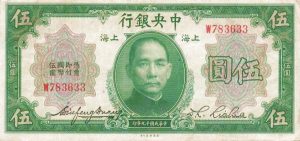Robert Farley

As we contemplate the global impact of changes in China’s currency regime, it’s worth looking back on how currency warfare, or competition in the domain of finance, has characterized East Asian politics over the past century. During the Second Sino-Japanese War, Tokyo waged parallel wars designed simultaneously to capture Chinese territory and destroy the integrity of China’s financial system. In his book “Currency and Coercion,” political scientist Jonathan Kirshner details the means that the Japanese and Nationalist governments (the latter supported by Washington and London) undertook in order to control China’s financial system.
The Chinese currency represented one of the key achievements of the Nationalist government during a period in which it could maintain only nominal authority over much of the country. As such, defending the currency from foreign attack was nearly as important as defending Nationalist territory against enemies foreign and domestic. Unfortunately, China had a limited ability to control its circumstances, especially as the Depression overtook the Western world. The American decision to purchase silver in great quantity in 1934 badly disrupted China’s monetary system, which had to that point been based on silver. In the face of a massive outflux of silver, the Nationalist government shifted to a free-floating paper currency, undergirded primarily by reserves of the U.S. dollar earned through silver sales.
Having only a fledgling defense industry, China required hard currency in order to purchase weapons not only for the continuing civil war against the Chinese Communist Party (CCP), but also for funding an anticipated future conflict against Japan. Most importantly, it required a stable, convertible currency in order to knit the disparate provinces together and offer legitimacy in the face of challenges from both the CCP and the Imperial Japanese invaders. Reserves of metal and U.S. dollars enabled the Nationalist government to stabilize prices and maintain its own currency. Nevertheless, China suffered from bouts of hyperinflation as different provinces mined and printed currency.
By 1937 the physical security of China’s remaining silver reserves had come under threat from the Imperial Japanese Army, further motivating the Nationalist government to export silver to the United States. As the war proceeded and Japan occupied a greater portion of Chinese territory, it began to offer its own regional fiat currencies, intended to replace the yuan and limit the extent of international and inter-regional trade. Because these currencies were not backed by metal or by any other reserve, they were not convertible into any foreign currency, and could only be used for trade with Japan. This thus represented a clever effort to redirect Chinese resources into the Japanese empire, while at the same time undercutting the legitimacy of Chiang Kai-shek’s regime in Chongqing.
The American and British appreciated the threat that Japanese efforts represented to the stability of the Nationalist government. In March 1939 the United States and the United Kingdom agreed to create a stabilization fund that would back the Chinese currency against further attack, although this was quickly dissipated. Furthermore, Great Britain helped the Nationalist regime smuggle currency into Japanese-occupied territories, offering some competition with the Japanese fiat currencies.
Kirshner concludes that while Japanese manipulation helped redirect the economies of occupied territories to Japanese markets, Tokyo failed to fully undermine the Chinese financial system and, as consequence, China was able to remain in the war. He further concludes that the efforts undertaken by the U.S. and the U.K. probably saved China’s currency at a relatively low cost to either country.
Future financial competition won’t play out like the 1930s. Still, the maintenance of a stable currency remains critical to legitimacy and prosperity, and most currencies have vulnerabilities that other players can exploit. It’s worth understanding past examples of financial coercion in order to appreciate how states have used money as the sort of weapon that can reach out and touch someone.
No comments:
Post a Comment